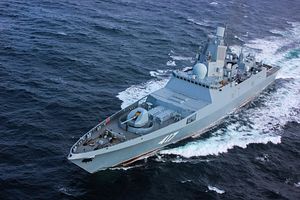The second Admiral Gorshkov-class (Project 22350) guided missile frigate, Admiral Kasatonov, will be delivered to the Russian Navy in 2019, according to the director general of Severnaya Verf shipyards in St. Petersburg, Russia.
“The second Project 22350 frigate, Admiral Kasatonov , is now 99 percent complete,” Igor Ponomaryov was quoted as saying by IHS Jane’s Navy International on October 1. “The first phase of the ship’s factory trials is scheduled for November, and both factory and state trials will be completed next year. We’re planning to deliver the ship to the navy by the end of 2019 or even earlier.”
The Admiral Kasatonov was initially slated for delivery in February 2018 and was to commence sea trials in July. However, this summer the head of the United Shipbuilding Corporation, Alexei Rakhmanov, announced that the ship would be delivered with at least an eight months delay in the last quarter of 2019. He cited November or December 2019 as possible delivery dates.
The 5,400-ton Admiral Gorshkov-class is the largest class of surface combatants to be built by Russia since the collapse of the Soviet Union and is expected to become the mainstay of the Russian Navy’s surface force in the near future. (Russia is also planning to field a larger variant of the frigate, designated Super Gorshkov-class.) However, the Admiral Gorshkov-class program has encountered multiple problems ranging from funding difficulties to engineering and construction issues since its inception.
These include performance and compatibility problems with the ship’s Polimut Redut air defense missile system and various technical hiccups with its propulsion system. Notably, while two other Admiral Gorshkov-class warships—the Admiral Golovko and Admiral Isakov—have been laid down in 2012 and 2013, it is unclear whether Russia will succeed in designing a functioning gas turbine engines for the frigates in time. (Ukraine-made gas turbine engines were used for the first two ships of the class.)
Admiral Gorshkov-class frigates are multi-purpose platforms designed for anti-air, anti-surface, and anti-submarine warfare missions. Like other Russian surface combatants, the principal armament of the class consists of stand-off anti-ship and land-attack cruise missiles. As I explained previously:
The ship’s primary weapon systems for anti-surface warfare missions will be the 3M-54 Kalibr, a stand-off supersonic anti-ship cruise missile with an estimated range of 270 to 410 miles, or alternatively the P-800 Oniks over-the-horizon supersonic anti-ship missile (or its more advanced derivative, the two-stage BrahMos missile) launched from vertical launch system cells. (The 3M-54 Kalibr is also available in land-attack and anti-submarine variants.)
The lead ship of the class was commissioned in July 2018. Notably, the ship took almost 12 years from keel-laying to commissioning, as I noted in the summer:
The first-of-class Admiral Gorshkov has been under construction for over a decade. The ship was laid down in 2006 and launched in 2010. It has been undergoing builder sea trials since November 2014. The final round of sea trials commenced in last March. Initially, the ship was expected to be commissioned in November 2016. However, due to various delays that date had to be pushed back to November 2017. That deadline also passed.
With the technical problems of the Admiral Gorshkov-class likely to endure for the foreseeable future, the Russian Navy is expected to focus its surface naval production on cheaper and smaller Steregushchy-class corvettes and its improved variant, designated Project 2038.6, in the near term as outlined in Russia’s State Armament Program for 2018-2027.
































